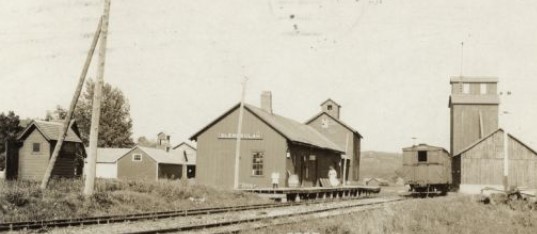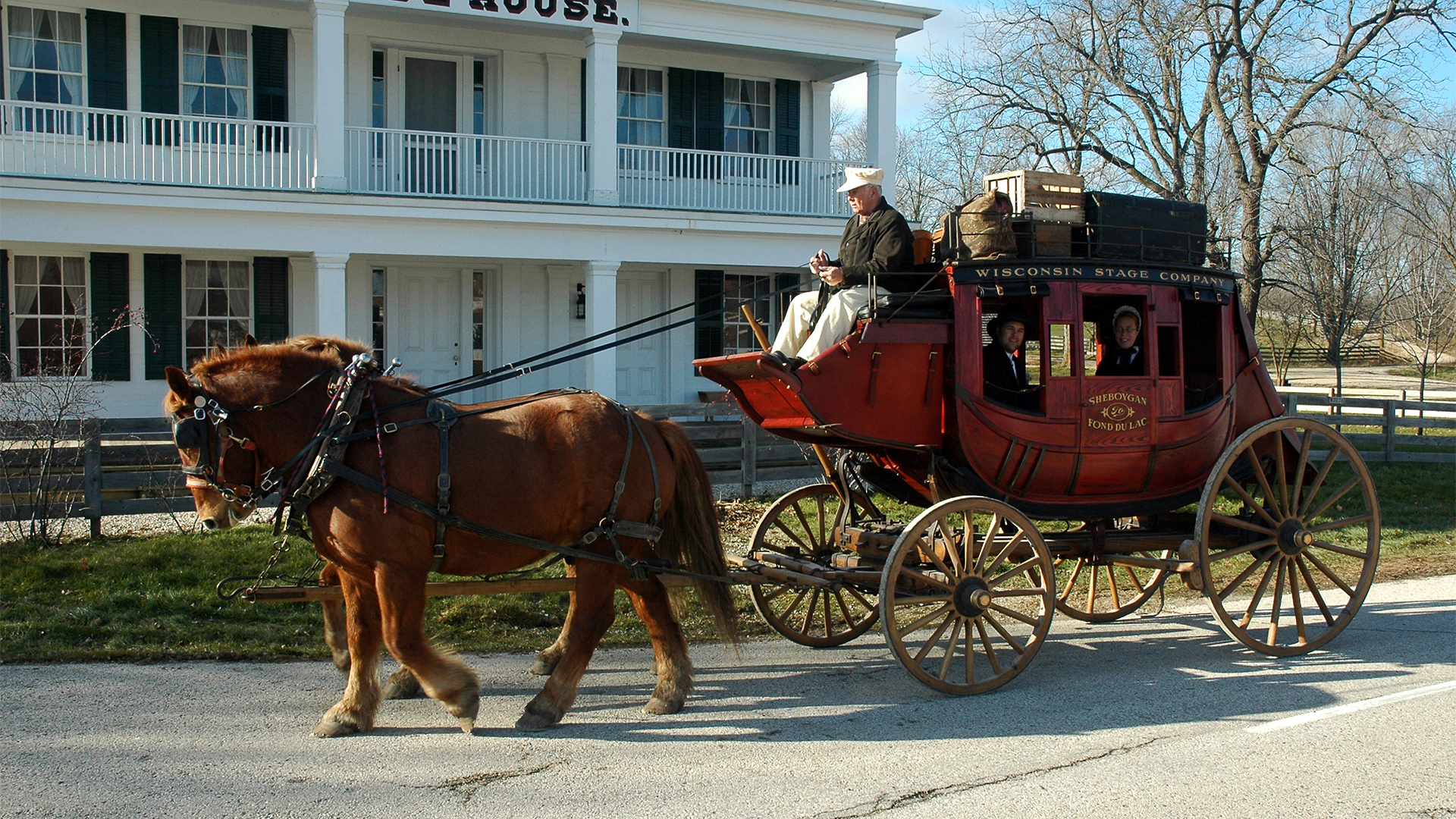
Our History
History of Wade House
The story of Wade House is a tale of European settlement, boom times and the capricious nature of development in the 19th century, dependent as it was on the vagaries of road and railroad development.

Wade Establishes Town in Frontier Territory
In 1844 Sylvanus and Betsey Wade and their nine children settled in what would become Greenbush. At that time Wisconsin was frontier territory and the northern Kettle Moraine of Sheboygan County was a virtually uninterrupted forest. Years later, Betsey Wade would tell her children that the forest was so dense that, even on a clear night, she “could hold in her apron all the stars she could see.” The Wades were the first permanent settlers of European descent in Greenbush. They had grand plans. They came to the remote area not to carve a single homestead out of the wilderness, but to establish a town on the developing frontier.
1848


Wisconsin became a state in 1848. By then, Greenbush was a booming little town with two stores, a school, a sawmill, a wagon shop, a blacksmith and a doctor. The trail running between Sheboygan and Fond du Lac had been improved and now served as a military and stagecoach road. There were plans for further improvements by building a plank road.
By 1848 Wade’s “Half Way House” was a regular stop for the stagecoach lines operating between Sheboygan and Fond du Lac. The Wades planned to build a new, large and elegant inn to serve the growing traffic. It would also lend an aura of establishment and civilization to the growing village of Greenbush.

Meanwhile…
Sylvanus and Betsey Wade selected the location for their village carefully. They chose a place halfway between Sheboygan and Fond du Lac along a well-used trail. The Mullet River crossed the trail, offering a promising source of waterpower. The Wades purchased several sections of land around a potential mill site as well.
Mullet River

1850
Wade House Stagecoach Hotel Opens
In 1850, just six years following their arrival, the Wades opened the new Wade House hotel to the public. It was built of locally harvested and sawn lumber. Its three-story, Greek Revival style reflected the architectural fashion of the “civilized” East. To travelers, Wade House represented the prosperity and progress of the young town. The hotel was the scene of cotillions, business meetings, political caucuses, and circuit court sessions. The taproom buzzed with debates of issues as mundane as last year’s crops and as heady as secession and the abolition of slavery.
The Wades must have believed boom times were on their way. Construction of the Sheboygan and Fond du Lac Plank Road began in 1851, seemingly ensuring that the Wades’ town and inn would continue to flourish.
1860
Heyday wanes, New Railroad Bypasses Greenbush
Unfortunately, the Wade House hotel heyday lasted little more than a decade. The second half of the 19th century belonged to the train. In the 1860s, the railroad became the main transportation artery between the port of Sheboygan and the interior of the state. The train bypassed Greenbush entirely, establishing a terminal two miles north, in Glenbeulah. By the mid-1860s, the growth and prosperity Greenbush had experienced stalled and the town became a sleepy rural hamlet. The building would continue to operate as a hotel for another decade. Three generations of the Wade family continued to live in the house until 1941.

1940
Restoration Plans Falter and the Hotel Deteriorates
In 1941 the hotel was sold by Sylvanus’ grandson, William Wade, to family friend Mary Dorst for $5,200. Mrs. Dorst planned to restore Wade House to its original 19th-century splendor and use the many Wade furnishings still within the house. Unfortunately, by 1949 Mrs. Dorst no longer had the funds to continue the repairs necessary to maintain or restore the building.

1950
100 years after its construction, Wade House was dilapidated but stood in a basically unaltered condition. Marie Christine Kohler and her sister-in-law, Ruth DeYoung Kohler, were soon going to bring Wade House’s rich history back to life. It was the vision of Marie Christine Kohler, daughter of Kohler Company founder John Michael Kohler, to restore the historic hotel to its 1850s heyday.
Ruth DeYoung Kohler enthusiastically took up her sister-in-law’s cause. The Kohler family and the Kohler Foundation purchased Wade House in 1950 and began a top-to-bottom restoration.

Restoration of the Robinson House
The foundation also acquired and restored the circa-1855 Butternut House, the residence of Charles Robinson, son-in-law of Wade House founder, Sylvanus Wade. The house’s first floor was opened as a series of period rooms. A blacksmith shop, framed with early timbers, was also reconstructed near the original location of the Henry Dockstader smithy that once fronted on the Plank Road near the Wade House.

Properly Deeded to the Wisconsin Historical Society
Ruth DeYoung Kohler personally directed the restoration and sought to deed the property to the Wisconsin Historical Society upon completion. Amid great fanfare, complete with an appearance by poet Carl Sandburg, Wade House opened to the public on June 6, 1953, as the Society’s second historic site.

Sadly,
Mrs. Kohler did not live to see the fruit of her labors. She passed away three months before the grand opening.
Ruth DeYoung Kohler
Wade House Joins the Wisconsin Historical Society



Wesley W. Jung Carriage Museum
In 1963 the Wisconsin Legislature voted to create a permanent home for the carriage collection of Wesley W. Jung, grandson of a Sheboygan carriage maker, at the Wade House site. In 1968 the Wesley W. Jung Carriage Museum opened to the public.
In one of the more transformative moments in the site’s history, a new 38,000-square-foot Visitor Center and Wesley W. Jung Carriage Museum opened to the public on June 8, 2013, 60 years to the week from the opening of Wade House historic site.
Herrling Sawmill Restoration
Restoration continued in 1999 when the Kohler Trust for Preservation pledged a $1.8 million gift to rebuild the Herrling Sawmill on its original site. The mill, which had stood in Greenbush throughout the second half of the 19th century, opened to the public on June 16, 2001.
Visitor Center
The new Visitor Center has direct access from Highway 23, offers engaging orientation exhibits, shopping, meeting and facility rentals spaces, together with a state-of-the-art, multi-faceted reinstallation of the site’s horse-drawn vehicle collection, the Wesley W. Jung Carriage Museum.

Award-Winning
In 2014 the new structure was awarded LEED Certification, and two American Society of Heating, Refrigerating and Air-Conditioning Engineers (ASHRAE) Technology Awards (1st place at the local ASHRAE level and 2nd place at the regional ASHRAE level). The ASHRAE Technology Awards recognize outstanding achievements by members who have successfully applied innovative building design in the areas of occupant comfort, indoor air quality and energy conservation.
More History
Learn more about the history of Wade House, Greenbush, and the Kohler Family by exploring the collections and archives at the Wisconsin Historical Society.
Images of History








